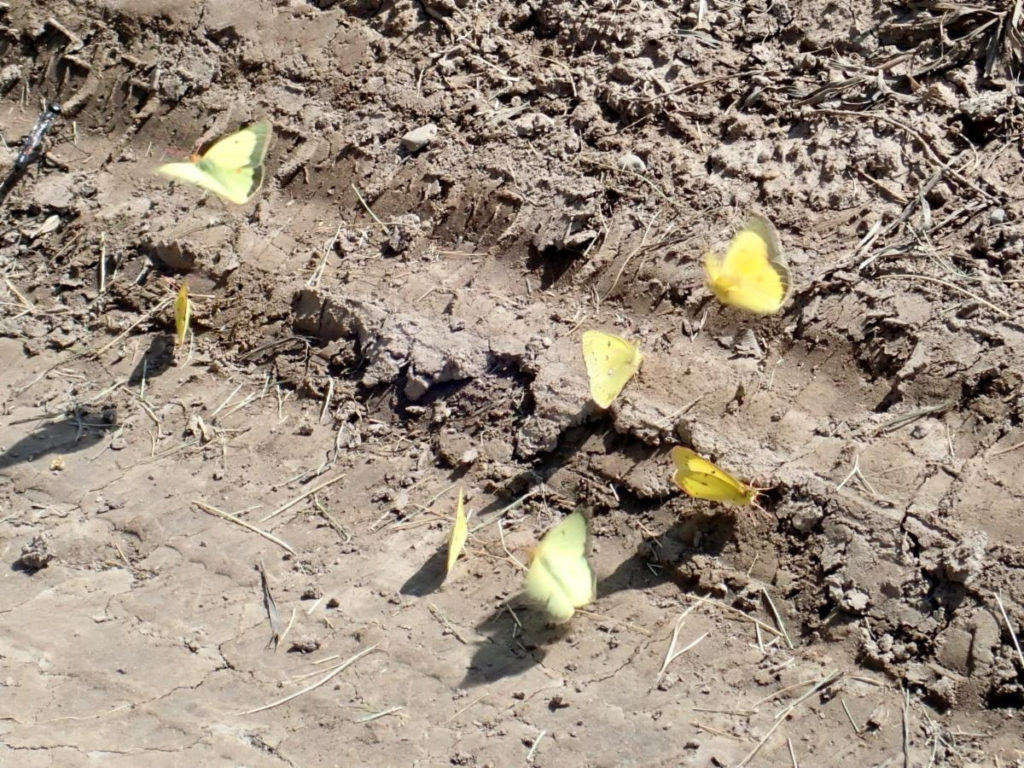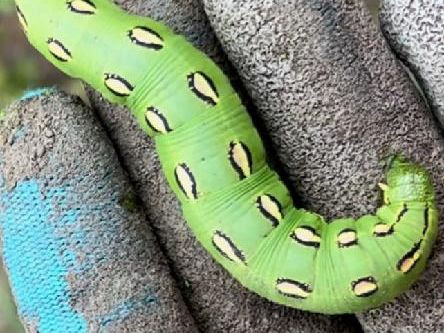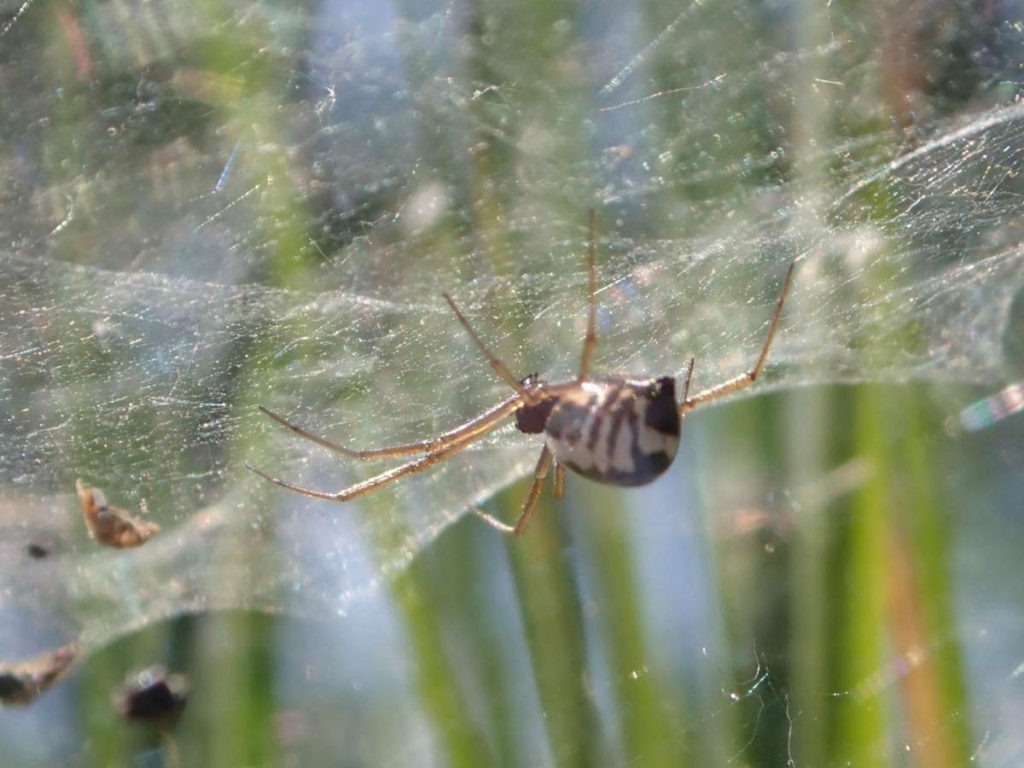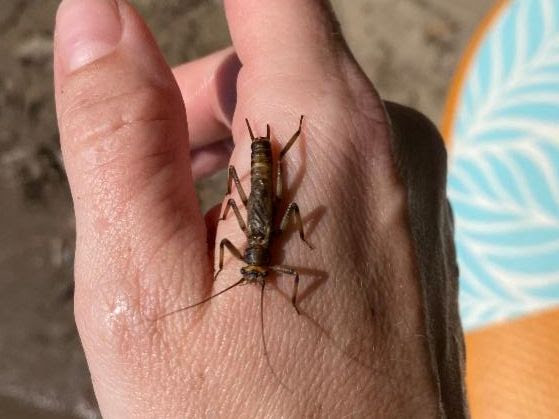Summertime and the buggin’ is easy. This week brings us several insects (and arachnids!) we’ve never featured before, from a beetle masquerading as a wasp to a spider who showed up ready for a tea party. Just when you think you’ve seen it all, something new lands in your lap (or flies into your face). Summer isn’t even close to over; what will you find out there?

Unnamed Prominent Moth
Datana californica
Had this moth perched somewhere less conspicuous, it may have been entirely missed. These cryptic moths have a distinct “rolled leaf” look, allowing them to blend in with surrounding foliage seamlessly. This species is found west of the Rockies, from southern BC to northern California. A similar species, D. ministra, is primarily found east of the Rockies. The genus name, Datana, is an anagram of two other moth genera, Natada and Nadata; all three were described by Francis Walker in 1855.
Judith Dammel, July 6th, 2023. Evaro, MT.
Parasitized Hecatera Caterpillar
Hecatera sp. & Euplectrus sp.
We believe this caterpillar belongs to the Hecatera genus – a member of the cutworm and dartworm moths – but the really interesting insect in this photo hasn’t hatched yet. The green clumps on the caterpillar’s back are parasitoid wasp eggs. We believe the eggs belong to a wasp in the genus Euplectrus, who specialize on parasitizing caterpillars in a variety of Lepidopteran species. The eggs are anchored to the caterpillar’s back and once they hatch, the unfortunate caterpillar will become the wasp larvae’s first meal.
Rose Marchak, July 8th, 2023. Mt. Sentinel, Missoula, MT.


Elm Sawfly Larva
Cimbex americanus
Despite the name, sawflies aren’t flies at all and reside in the order Hymenoptera, along with the more familiar wasps, bees, and ants. Females don’t pack a sting, but most species have a sawlike ovipositor that they use to cut into plant tissue before laying an egg. The Elm Sawfly is the largest North American sawfly, measuring up to an inch long, with the caterpillar-like larvae stretching to two. It ranges from Alaska to Newfoundland, south to North Carolina and Oregon.
Rose Marchak, July 8th, 2023. Mt. Sentinel, Missoula, MT.
Unnamed Flower Longhorn Beetle
Necydalis diversicollis
Did you think you were looking at a wasp? So did we, at first! Necydalis diversicollis is a species of flower longhorn beetle, but with their slender body and shortened elytra, we can forgive you for thinking otherwise. There’s not much info on this species – nor the genus or even tribe. But as a member of the flower longhorn beetle subfamily (the second unnamed submission this week), they are probably found feeding from flowers.
Glenn Marangelo, July 8th, 2023. Missoula, MT.


Clouded Yellows
Colias sp.
These puddling butterflies wouldn’t sit still long enough to get a close-up, so we can only confirm that they belong to the genus Colias, the clouded yellows (or sulphers). All members of this genus are migratory to some degree; some species move up and down in elevation in response to temperature and plant growth. Others undertake significantly longer migrations, traversing north to south across the United States in the fall along with many other migratory animals.
Brenna Shea, July 7th, 2023. MPG Ranch, Florence, MT.
Unnamed Flower Longhorn Beetle
Judolia instabilis
The pattern on this western species of flower longhorn beetle differs significantly between individuals, making ID tricky – but not impossible. They are found throughout western North America, from southern Canada to northern Mexico. Adults are often found feeding on flowers, while their larvae prefer pines. As adults, they range in color and size, too – from 6 mm to 15 mm in length.
James Peterson, July 6th, 2023. Missoula, MT.


Western Bumblebee
Bombus occidentalis
Capturing a clear photo of a bumblebee is tricky. Still, we had to include this one because B. occidentalis was once one of the most common bumblebees in western North America, with a geographic range spanning from southern California to Alaska. Unfortunately, in the last decade, their population has dropped by 40%, no doubt accelerated by human impacts and climate change. Seeing one in the wild is a hopeful reminder that they are still around, and with some effort, they will be for good!
Glenn Marangelo, July 7th, 2023. Missoula, MT.
Western Sculpted Pine Borer
Chalcophora angulicollis
The only western species in the genus Chalcophora, the western sculpted pine borer is so named for the “sculpted” look of the elytra and thorax. As a member of the metallic wood-boring beetle family, it doesn’t comes across as “metallic” at first; but once she lifts her elytra (wing covers) for takeoff, the striking blue and purple iridescence of the abdomen is revealed. If one is flying nearby, you’ll likely hear it before you see it. These large beetles are conspicuously (and sometimes alarmingly) loud aviators.
Rose Marchak, July 8th, 2023. Mt. Sentinel, Missoula, MT.


Digger Bee
Anthophora sp.
With over 450 species in the genus Anthophora, it may not be possible to identify this striking bee to species. As solitary bees, they do not have the backing of a colony to help forage or defend from predators, though some will nest together in aggregations. As their name suggests, these bees nest in the soil, in flat ground or embankments. Their eyes are sometimes pale green; a striking diagnostic characteristic.
Glenn Marangelo, July 8th, 2023. Missoula, MT.
White-lined Sphinx
Hyles lineata
While the white-lined sphinx caterpillars show considerable variation in their coloring, the adults are somewhat uniform in their colors and are recognized by the numerous white lines covering their wings; that, and their large, furry bodies and day-flying habits. This moth is found throughout the United States; their caterpillar is often referred to as the “purslane caterpillar,” which is subsequently where this individual was found.
Laurie Kallis, July 7th, 2023. Wallace Creek, Clinton, MT.


Bowl-and-doily Spider
Frontinella pyramitela
This spider’s descriptive common name comes from its unique web shape. As a member of the sheetweb weaver subfamily, they will create a flat, horizontal web; but above that, they create a bowl-shaped web, giving the entire structure the look of a bowl sitting atop a decorative doily. Their distinctive patterning gives them the look of a young widow spider, but they lack medically significant venom.
Brenna Shea, July 7th, 2023. MPG Ranch, Florence, MT.
Wolf Spider
Pardosa sp.
Pardosa sp. are recognized by the perpendicular spines on their hind legs. Wolf spiders are constantly on the move. Females attach their egg sac to their spinnerets and take them wherever they go. Once they hatch, the spiderlings climb onto their mother’s back until they are large enough to venture out on their own. These spiderlings are still young enough to hitch a ride on mom’s back.
Brenna Shea, July 7th, 2023. MPG Ranch, Florence, MT.


Shortwing Stonefly
Claassenia sabulosa
These large stoneflies get their name from their shortened wings, a trait that may hinder dispersal but certainly doesn’t slow them down. Once the adult males emerge, they can be seen scrambling across rocks, looking for a female. If he finds one that hasn’t molted into her adult stage yet, he will guard and mate with her as soon as she does (sometimes doing so before her exoskeleton has hardened). Like most stoneflies, the aquatic nymphs require clean, cold-flowing streams to thrive and are commonly used as indicators of stream health.
Brenna Shea, July 9th, 2023. Missoula, MT.
Bunchgrass Locust
Pseudopomala brachyptera
Don’t let the name “locust” throw you into a panic. This grasshopper, also known as the “short-winged toothpick grasshopper,” is not known to swarm and feeds on a variety of native grasses – not crops. As such, they are often found in open fields with tall bunch grasses. The males will court the females by approaching slowly; they stop frequently, singing her a song by stridulating his legs each time. Not much is known about their reproductive history or lifecycle, but it is assumed that they overwinter in their nymph stage, as both nymphs and adults can be found in the fall.
Brenna Shea, July 7th, 2023. MPG Ranch, Florence, MT.
